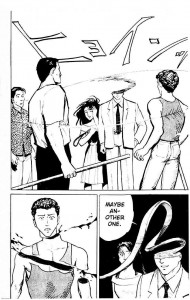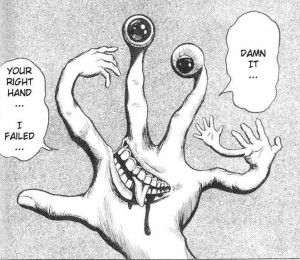Despite Alison Bechdel, despite Marjane Satrapi, despite manga, women are still in many ways marginalized in American comics. And if you are a marginalized group, there are generally two ways to go about advancing your lot. You can work towards integration. Or you can work towards establishing your own institutions. Martin or Malcolm, Betty Friedan or Shulamith Firestone, the questions remain the same. Do you want to be given access to the institutions? Or do you want to change them? These two positions aren’t always or necessarily opposed, of course — some people may have voted for Barack Obama both because it marked an important moment in integration, some may have voted for him because they hoped he would change the country, and a lot of people probably voted for him for both reasons. Still the goals don’t always dovetail so nicely; often you have to pick which to prioritize, and how.
These issues were the subtext of much of the discussion at a panel on “Gender and Cartooning in Chicago,” which I attended in April. The panel was organized by Anne Elizabeth Moore (former editor of The Comics Journal and Punk Planet) and featured cartoonists Nicole Hollander (Sylvia) and Dewayne Slightweight (The Kinship Structure of Ferns, I Want to Know the Habits of Other Girls.) Each of them had thought about the problems of being a women in a male dominated field, and each had come to somewhat different conclusions about how to best advance their careers and their art.
Dewayne Slightweight (who is an acquaintance of mine) is not widely known, but he’s a remarkable young artist. Though he’s female, he identifies as genderqueer, and prefers to be referred to by the male pronoun. As this suggests, Slightweight’s thought a good bit about identity; his work is very consciously focused on exploring and building, as he put it, “feminist or queer or anti-capitalist community.” His comic The Kinship Structure of Ferns attempts “to make an art that communicates a new form of kinship” built around “love, hope, desire, and friendship.” Slightweight argued that “hierarchical capitalist culture privileges sight,” by, for example, saying, “I know what a woman looks like,” or “I know what a terrorist looks like.” So in his work, Slightweight tries to complicate looking by turning his comics into performances; he will project them on a screen and dance and sing in front of them, contrasting his body with drawn bodies and with music. He includes a CD of musical accompaniment with each comic as well, the effect of which is pleasantly disorienting. As you read and listen along, words and phrases pop out and repeat in odd, out of sync ways, breaking linear progress up into effervescent bubbles of sound and meaning.
Slightweight’s focus on separate communities and non-hierarchical experience is mirrored in his career. All of his work is self-published; most of it is not sold, but traded with friends in the underground rock and queer arts communities of which he is a part. When asked about his take on current cartooning or mass culture, Slightweight said that he had not bought a book or comic or record in something like three years. Partially this is because he makes virtually no money; he said he walks during the winter rather than taking the bus in order to save up the funds to put out his comics, and he mentioned that one of his main sources of support is food stamps. In addition, though Slightweight noted that he isn’t part of the comics scene, mainstream or alternative, because he doesn’t want to be. “I don’t need to pay attention to what dude is the up and rising star,” he pointed out. Nor does he need to worry about sexism or discrimination, since the underground community of which he is a part has lots of women, and lots of queers, and lots of feminist men. “A grouping of women and queers is not a ghetto — it’s a wonderful thing,” he said.
Slightweight, then, is committed to a separatist rather than an integrationist model of feminist culture; when asked if he would be more interested in the mainstream if it included more interesting, feminist-friendly work, his answer was essentially, “no.” For Slightweight, the very existence of the mainstream is the problem; he argued that the point of feminism was to decentralize power. “You have as much right to talk back to culture as culture has to talk to you,” he said. The point, then, for Slightweight, is not for marginalized groups to step into positions of power, but for them to speak from where they are, and so break down a hierarchy which insists on privileging certain creators or certain voices.
Nicole Hollander, the creator of the strip Sylvia, began her career as a comics professional when women were even more underrepresented in the industry than they are now. She is also a newspaper political and strip cartoonist, segments of comicdom that are perhaps the least gender-integrated. (Anne Elizabeth Moore pointed out that there had been only one female editorial cartoonist in the United States — before she was fired in the recent economic bloodletting.) It is no surprise, then, that Hollander spent a good part of her discussion talking about the barriers she had faced as a woman to mainstream success.
Hollander began her career illustrating articles for The Spokeswoman, a feminist, political magazine. After receiving some interest from book publishers, and inspired in part by Doonesbury, she tried to syndicate Sylvia — at which point she ran up against something that looked rather like sexism. One syndicate executive told her that her strip was “deep, but narrow” — narrow, presumably, because it didn’t have any men in it.
Faced with mainstream disinterest, Hollander turned to DIY. She worked to syndicate herself, phoning up newspapers on her own behalf. Though she made some sales, being a woman was a disadvantage here too — newspaper editors would often tell her, as she put it, “We have Cathy already. One woman is quite enough, thank you.” Nonetheless, she managed to land the strip at one paper and another, and to cobble together book deals, performance opportunities, and a certain amount of fame, if not exactly a fortune.
Hollander discussed not only the lack of opportunities for, but also the lack of representation of, women on the comics page. “Men want to write about men,” she noted, and pointed out that there would only be more strips for women when there were more women creators with access to the comics page. As it stands now, Hollander said, girls don’t generally think of becoming cartoonists. She herself, she said, had not been interested in comics as a girl; as a child she had liked the Phantom and Broom Hilda, but as an adolescent, comics had offered her nothing.
All of this might suggest that Hollander sounded bitter…but that wasn’t the case at all. On the contrary, she pointed out that in her experience it was her male colleagues who often complained about low pay or that they could not make a living at cartooning. As for herself, she noted, “I wish I had more money…but I feel very happy in my career. I’ve been able to say everything I wanted to say. I was able to say “vibrator” in one strip. I was able to say “orgasm”” At another point she added, “I could be Sylvia. I could be tough.” Thus, though Hollander would have liked more mainstream success, she also has appreciated the freedom which came with being on the margins.
In contrast to both Slightweight and Hollander, Anne Elizabeth Moore is somebody who follows the comics industry closely. She is in the process of conducting a series of interviews with female comics professionals, and she seems to know just about everybody there is to know. She said that for her it was very important to try to accrue mainstream power in order to promote people like Slightweight and Hollander, “whose work should be everywhere!” as she said. At the same time, she noted, when you participate in the mainstream, you end up “subverting rather than changing.”
Though Moore seemed to be at least provisionally interested in working with the mainstream, she also argued for a need for more female institutions. In response to a question from the audience about the lack of female representation in Kramer’s Ergot, and Sammy Harkham’s reportedly snotty defense of same, Moore suggested that there was a need for more (or even one) female comics anthology.
The final statement of the evening came from a Korean-born woman in the audience. She noted that growing up in Korea, she had constantly read comics by women, for women. She very rarely read any comics by men, because they were overly violent, because they focused on male characters, and because, with so many comics written by women, she didn’t have to, so why would she? In Korea, in other words, comics for women are their own separate genre and have their own audience — but that separate institutional framework is so large and so strong that it is, in fact, effectively of the mainstream. The women added that when she got to America, it was a shock to realize that women here weren’t drawing, writing, or reading comics in large numbers. “It made me really sad,” she said.
________
This essay first appeared in The Comics Journal. Since it appeared, Sylvia has been cancelled in the Chicago Tribune, it’s home paper. The Chicago Reader has the story, as well as info about what you can do if you would like to try to get the decision changed.
Update Jan 2014: Dewayne Slightweight now goes by the name Lee Relvas.




